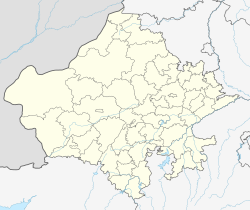Анг Глаз Храм
| Храм Амбика | |
|---|---|
 | |
| Религия | |
| Принадлежность | индуизм |
| Божество | Дурга |
| Расположение | |
| Расположение | Джагат -деревня недалеко от Удайпура , Раджастхан |
| Geographic coordinates | 24°17′28.2″N 73°50′43.2″E / 24.291167°N 73.845333°E |
| Architecture | |
| Style | Māru-Gurjara architecture |
| Date established | 961 CE |
Амбика Мата Мандир - индуистский храм , расположенный в деревне Джагат, примерно в 50 км к юго -востоку от Удайпура в штате Раджастхан , Индия . [ 1 ] Амбика Деви, форма богини Дурга - председательствующее божество храма. Он был построен под правлением Равала Аллата Мевара. [ 2 ] Храм, расположенный в расщелине скалы, обладает рядом надписи. Самый ранний, датированный 961 г. н.э., относится к ремонту, сделанного ему. [ 3 ] Сегодня храм сохраняется Государственным департаментом археологии и музея Раджастханом.
Храм является ранним, переходным, примером стиля, известного как архитектура Мару-Гурджара . [ 4 ]
Это малоизвестный храм, начиная с десятого века с изображениями Дурги [ 5 ] [ 6 ] [ 7 ] и многие другие женские божества. Амбика, форма индуистской богини Дурга, является основным образованием в святыне и поклоняется как Шакти , первобытный источник энергии. [ 8 ] Она ассоциируется с Дургой через свою левную гору и связана с джайнами через видение, консультирующее Вималу о строительстве своего храма Адинатх на горе Абу . [9]
Architecture
[edit]The temple is also known as the Khajuraho of Mewar.[10] There are many fine sculptures in the temple which have been excellently preserved. This pentagonal temple, enclosed by a massive rampart wall, has 17 turrets and a pagoda-like gabled roof. Exquisite details appear high on the exterior walls of the temple, above larger sculptures of gods or goddesses, with musicians,[11] dancers, and singers of the heavenly court, as well as countless beautiful women.[12] The richness and arrangement of the carving often has a curling vegetal motif. The theme is of a mountain palace, a heavenly abode of the gods. The tower is covered with intricate motifs, including clouds, and is surrounded by small shikhara towers which echo the surrounding mountain peaks. The architecture of the mountain palace, as the heavenly abode of the gods, echoes the temple which is their earthly residence.[13]
Sculptures
[edit]
As a Devi temple, most of the sculptures here represent either (1) Durga, the fierce devi, or (2) Lakshmi and other beneficent devis, or (3) Brahmani and other theoretical counterparts of the traditional (male) Hindu divinities.
-
Ladies of the Heavenly Court.Ambika Mata temple, Jagat. This section of the wall is decorated with goddesses in various postures: holding an Eka-tantri vina (photo left), playing a vina (type unknown) while supported by an elephant (photo center), and holding a child (photo right).
-
A fierce form of Devi, Chamunda is portrayed as a frightening, emaciated hag. Her attributes include fangs, a sword, Shiva's trident, skull garland, skull staff, skull bowl, and skeletal corpse which she tramples or sits on. Woman playing eka-tantri vina, far right.
-
Musician's playing flute and a vina.
-
Roof model
Notes
[edit]- ^ "Temples of Western India". Archived from the original on 8 October 2006. Retrieved 15 September 2006.
- ^ Somānī, Rāmavallabha (1976). History of Mewar, from Earliest Times to 1751 A.D. University of Michigan: Mateshwari Publications. p. 54.
- ^ Deva, Krishna (1985). Temples of North India, New Delhi: National Book Trust, pp.31-2
- ^ Harle, 220-221 (though Harle does not use this term).
- ^ "Durga Ambika Mata temple, Jagat - Photo". Archived from the original on 23 October 2006. Retrieved 19 September 2006.
- ^ "Durga with bow - Photo". Archived from the original on 16 October 2006. Retrieved 19 September 2006.
- ^ "Durga with snakes - Photo". Archived from the original on 16 October 2006. Retrieved 19 September 2006.
- ^ "Abodes of Shakti". Archived from the original on 17 September 2006. Retrieved 15 September 2006.
- ^ "Ambika Mata Temple". Archived from the original on 8 August 2006. Retrieved 15 September 2006.
- ^ "Jagat Temple". India9.com.
- ^ "Небесные музыканты" . Архивировано из оригинала 23 октября 2006 года . Получено 23 сентября 2006 года .
- ^ "Surasundaris" . Архивировано из оригинала 23 октября 2006 года . Получено 23 сентября 2006 года .
- ^ "Угловой деталь" . Архивировано из оригинала 23 октября 2006 года . Получено 15 сентября 2006 года .
Ссылки
[ редактировать ]- Harle, JC, Искусство и архитектура индийского субконтинента , 2 -е изд. 1994, издательство Йельского университета Пресс Пеликан История искусства, ISBN 0300062176
Дальнейшее чтение
[ редактировать ]- Стейн, Дебора Л. «Кража Амба Мата: Онтология местоположение и батариализм Груганса Баталя», Res: антропология и эстетика (весна 2010): 264–2





